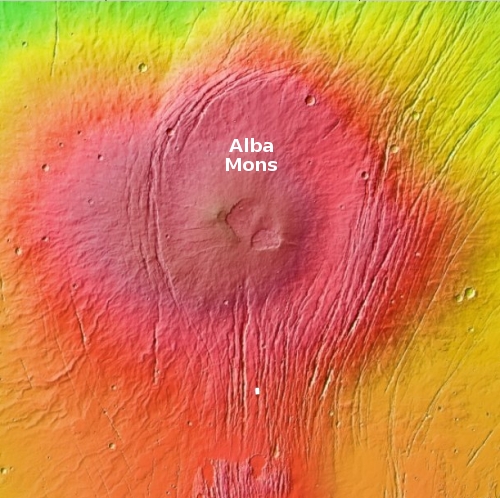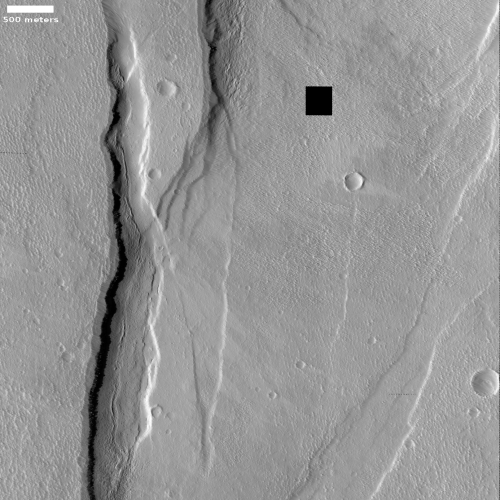Ice, lava, quakes, and faults, all in one Martian image
Cool image time! The photo to the right, rotated, cropped, and reduced to post here, was taken by the high resolution camera on Mars Reconnaissance Orbiter (MRO) on April 25, 2021. It grabbed my attention because it possibly captures a whole range of Martian geological processes, all in one place, including evidence of quakes, of lava, of faults, and possibly of glaciers.
First, ignore the black rectangle, which is merely a small section of lost data.
The picture itself shows a wide north-south fissure, as indicated by the distinct western cliff and the fainter and less pronounced eastern cliff. This fissure, likely formed along a fault, was created when the crust was pushed and stretched upward by the pressure of underground volcanic magma, part of the long series of eruptions that formed the many similar and parallel north-south fissures south of the shield volcano Alba Mons.
The overview map below illustrates this fissure’s relationship with Alba Mons.

That upward stretching would have caused quakes as the ground was shifted, stretched, and cracked. Such cracks are called grabens by geologists, places where two pieces of surface crust become offset along a fault when one drops or the other rises.
Within this fissure however is material that suggests vaguely, but not certainly, the presence of buried glacial ice. The latitude is 33.5 degrees north, which places it far enough away from the equator for such glaciers to exist.
At the same time, the altitude is high, which tends to be dryer on Mars. The material filling the fissure could also be flood lava, coming downhill from Alba Mons to the north.
What strengthens the hypothesis that the material in the fissure is ice is the small secondary crack on its western edge. While this smaller canyon’s interior has many features suggestive of glaciers, it also appears that whatever flowed down this canyon ate into the material in the main canyon. If so, it is possible that the small canyon was a lava vent that when it reached the main canyon acted to heat and melt away the main glacier there.
All guesses, though taken all together the image suggests that both ice and lava contributed to this geology, after it was first formed by quakes and volcanic eruptions. A busy place indeed.
On Christmas Eve 1968 three Americans became the first humans to visit another world. What they did to celebrate was unexpected and profound, and will be remembered throughout all human history. Genesis: the Story of Apollo 8, Robert Zimmerman's classic history of humanity's first journey to another world, tells that story, and it is now available as both an ebook and an audiobook, both with a foreword by Valerie Anders and a new introduction by Robert Zimmerman.
The print edition can be purchased at Amazon or from any other book seller. If you want an autographed copy the price is $60 for the hardback and $45 for the paperback, plus $8 shipping for each. Go here for purchasing details. The ebook is available everywhere for $5.99 (before discount) at amazon, or direct from my ebook publisher, ebookit. If you buy it from ebookit you don't support the big tech companies and the author gets a bigger cut much sooner.
The audiobook is also available at all these vendors, and is also free with a 30-day trial membership to Audible.
"Not simply about one mission, [Genesis] is also the history of America's quest for the moon... Zimmerman has done a masterful job of tying disparate events together into a solid account of one of America's greatest human triumphs."--San Antonio Express-News
Cool image time! The photo to the right, rotated, cropped, and reduced to post here, was taken by the high resolution camera on Mars Reconnaissance Orbiter (MRO) on April 25, 2021. It grabbed my attention because it possibly captures a whole range of Martian geological processes, all in one place, including evidence of quakes, of lava, of faults, and possibly of glaciers.
First, ignore the black rectangle, which is merely a small section of lost data.
The picture itself shows a wide north-south fissure, as indicated by the distinct western cliff and the fainter and less pronounced eastern cliff. This fissure, likely formed along a fault, was created when the crust was pushed and stretched upward by the pressure of underground volcanic magma, part of the long series of eruptions that formed the many similar and parallel north-south fissures south of the shield volcano Alba Mons.
The overview map below illustrates this fissure’s relationship with Alba Mons.

That upward stretching would have caused quakes as the ground was shifted, stretched, and cracked. Such cracks are called grabens by geologists, places where two pieces of surface crust become offset along a fault when one drops or the other rises.
Within this fissure however is material that suggests vaguely, but not certainly, the presence of buried glacial ice. The latitude is 33.5 degrees north, which places it far enough away from the equator for such glaciers to exist.
At the same time, the altitude is high, which tends to be dryer on Mars. The material filling the fissure could also be flood lava, coming downhill from Alba Mons to the north.
What strengthens the hypothesis that the material in the fissure is ice is the small secondary crack on its western edge. While this smaller canyon’s interior has many features suggestive of glaciers, it also appears that whatever flowed down this canyon ate into the material in the main canyon. If so, it is possible that the small canyon was a lava vent that when it reached the main canyon acted to heat and melt away the main glacier there.
All guesses, though taken all together the image suggests that both ice and lava contributed to this geology, after it was first formed by quakes and volcanic eruptions. A busy place indeed.
On Christmas Eve 1968 three Americans became the first humans to visit another world. What they did to celebrate was unexpected and profound, and will be remembered throughout all human history. Genesis: the Story of Apollo 8, Robert Zimmerman's classic history of humanity's first journey to another world, tells that story, and it is now available as both an ebook and an audiobook, both with a foreword by Valerie Anders and a new introduction by Robert Zimmerman.
The print edition can be purchased at Amazon or from any other book seller. If you want an autographed copy the price is $60 for the hardback and $45 for the paperback, plus $8 shipping for each. Go here for purchasing details. The ebook is available everywhere for $5.99 (before discount) at amazon, or direct from my ebook publisher, ebookit. If you buy it from ebookit you don't support the big tech companies and the author gets a bigger cut much sooner.
The audiobook is also available at all these vendors, and is also free with a 30-day trial membership to Audible.
"Not simply about one mission, [Genesis] is also the history of America's quest for the moon... Zimmerman has done a masterful job of tying disparate events together into a solid account of one of America's greatest human triumphs."--San Antonio Express-News


